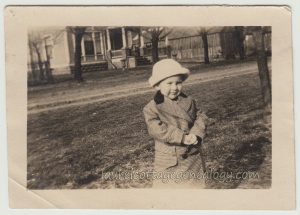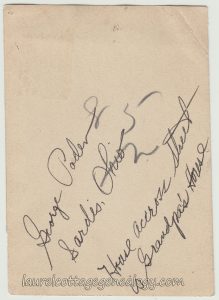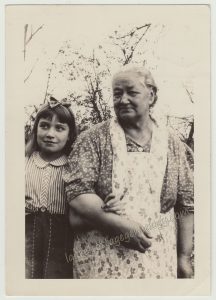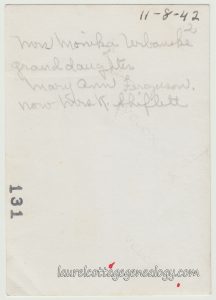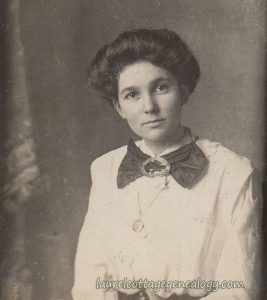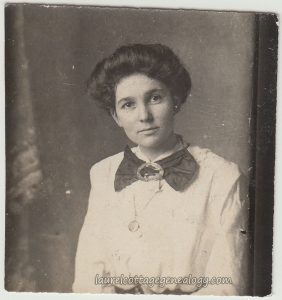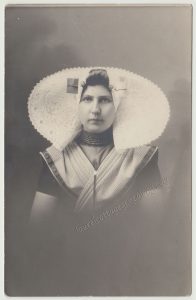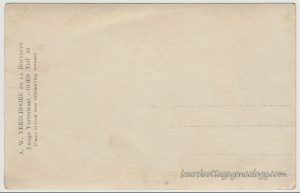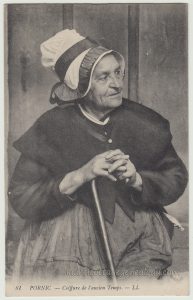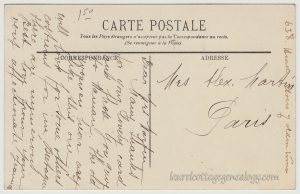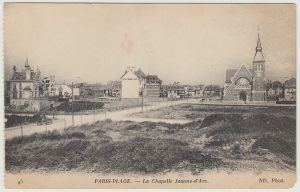
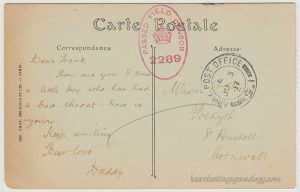
Divided back postcard. Postmarked July 3, 1917, Army Post Office. Stamped: Passed Field Censor 2289. Publisher/printer: Neurdein & Co., Paris.
Price: $10.00
Plage is beach, so….beach in Paris or Paris Beach? Ahhh, so the full name of the town is actually Le Toquet Paris-Plage, which is located in northern France, on the shores of the English Channel. Le Toquet was, at one time, known as “Paris-by-the-Sea.”
Addressed to: “Master J. Obery, Polkyth, Saint Austell, Cornwall.”
“Dear Frank. How are you. I saw a little boy who has had a bad throat – how is yours. Keep smiling. Best love Daddy”
J. Obery was Francis John Patrick Obery, born East Ham, Essex, London in 1910, son of Edward Richard Hooper Obery, born about 1879 and Kate Hooper, born about 1876, who had married on August 5, 1905, in St. Austell, Cornwall. The parish marriage register shows the groom’s occupation as schoolmaster and that his father’s name was John Edward Oliver Obery. (Two middle names were seemingly a tradition.) Kate’s father was Francis Hooper. Edward’s address at the time of marriage was 141 Milton Ave., E. Ham, London and Kate had been living in Watering Hill, Cornwall.
It’s hard to write about some of these cards and photos sometimes. Maybe because there’s that familiar feeling of being able to walk over to the next block and find the Obery Family, or a sense somehow of a trillion points in a person’s life with connections back to ancestors, and forward to their descendants, an overwhelming fullness you can feel but that’s difficult to translate…..
That said, a quick look at the 1911 census shows Edward, Kate, Francis and Edward’s widowed mom, Phillipa Obery, all at 141 Milton Avenue. We later picture the Oberys, minus Edward, locating to Cornwall to stay with Kate’s family, for hopeful safekeeping, while holding Edward in their constant prayers. For context re the move to Cornwall, the month prior to this card being written, 162 civilians were killed in a German daylight air raid on London, June 13th. Another 57 civilian lives were lost in another raid July 7th, just four days after the postmarked date on the card.
Edward served in the Army Veterinary Corps and yes, thank God, he did make it back to his family.
A little about the postcard image: So, this would have been produced from a photo, not necessarily true to the original, as sometimes the printer or publisher removed or added things (according to what they felt was needed). Anyway, there are some nice details to pick out within the full scene. (The whole is maybe reminding you of a bunch of miniatures set up in a reproduction.) We notice that the road’s edges must slope downward, since the car’s on an angle, driving “in the ditch” some would call it 😉 ; there’s one of those wooden pole fences held together by wire, leaning a little this way and that, as they are wont to do, the fence looking out-of-place with the very stately 4-story building behind it (Or vice-versa!) Moving to our right, we can partially read a sign for an Auto Garage; sweeping further, we pick out three buildings that have half-timbering on a portion of their facades (the vertical stripes with some diagonals) and then of course there’s the church, Saint Joan of Arc, which is not very old at all at this time, having first opened July 14, 1911. (Incidentally this church sustains damage in the Second World War, but is then, thankfully, able to be restored.)
Sources: Le Toquet. n.d. https://en.wikipedia.org/wiki/Le_Touquet (accessed November 11, 2020).
England, Cornwall Parish Registers, 1538-2010. Salt Lake City, Utah: FamilySearch, 2013. (Ancestry.com).
Class: RG14; Piece: 9565; Schedule Number: 88. 1911 England Census. (Ancestry.com).
“The First World War. Spotlights on History. Long Range Bombers.” nationalarchives.gov.uk. (accessed November 14, 2020).
The National Archives of the UK (TNA): Public Record Office (PRO). Ancestry.com. UK, British Army World War I Service Records, 1914-1920.
Ancestry.com. England & Wales, National Probate Calendar (Index of Wills and Administrations), 1858-1995.

